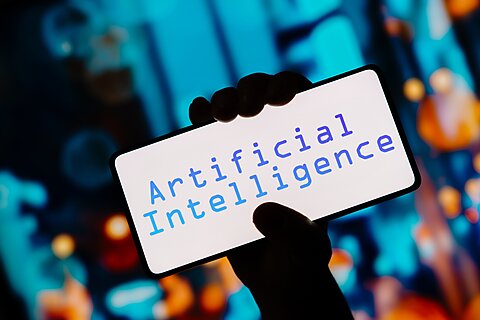
Adam N. Michel
OpenAI released Chat GPT‑3 a year ago this month. The subsequent diffusion of ever more sophisticated artificial intelligence (AI) computer models drives near‐daily innovations (and corporate intrigue), such as breakthroughs in biomedical research and improvements to autonomous transportation systems.
Techno‐optimists believe these AI models are poised to revolutionize work and leisure. However, many of the same optimists, like Sam Altman, CEO of OpenAI, fear that AI’s transformations could “break capitalism” through a “shift of leverage from labor to capital,” and undermine the role of traditional work in our economy. Such worry has led the likes of Bill Gates to suggest new taxes on the income earned by AI or robots to slow the economic transition and fund new income‐transfer programs.
Contrary to that narrative, empirical evidence does not support the worker displacement theory. New taxes on capital will make achieving the positive gains promised by AI or any other future innovation less likely. If the revenue is used to fund new income‐support programs, it could also undermine labor supply.
Workers Are Not Losing a Competition with Capital
Historically, economic and technological changes have stoked fears of widespread worker displacement. Yet, time and again, these fears have not fully materialized. From the Luddite movement’s opposition to mechanized looms during the Industrial Revolution to the anticipated job losses following the personal computer’s introduction, these fears have consistently proven unfounded. Instead, each innovation has ultimately improved workers’ wages and conditions.
Neoclassical economists attribute economic output to the combination of capital, labor, and technological innovations. Capital and labor’s contribution to output is described by an elasticity or, more colloquially, each component can be thought of as earning a share of national income. If, over time, capital became more important for economic output, capital’s share of income would increase. Figure 1 uses data from the US Bureau of Economic Analysis to show that the labor share of net income (net of taxes and depreciation) is within its historical range, fluctuating above and below the average of 69 percent.
Labor’s share increased slowly from 1930 through 1970 and remained above 69 percent through 2005, as it declined slightly before returning to the century‐long average. In 2022, the labor share was 68 percent, and in the second quarter of 2023, labor’s share of net income increased to 70 percent.
In the neoclassical model, there is a limit to how much additional work or investment can be induced by policy. In the medium term, the number of workers and machines is finite. Thus, long‐run growth is primarily driven by technological progress, which combines with labor and capital to increase productivity and allow the same workers to work more efficiently with new and better tools (capital).
Technological progress flows from new ideas employed by entrepreneurs that allow people to use existing resources more efficiently. Capital and labor are complements and substitutes. Thus, in theory, productivity‐increasing technologies could increase either worker or the capital contribution to income. These new technologies have always replaced some jobs but, in the process, created entirely new industries and increased demand for labor. Empirical evidence of labor shares across countries demonstrates that technological progress has not altered the power dynamics between labor and capital—as reflected in the relatively stable labor share of income in Figure 1.
Other research also consistently finds that pay and productivity (correctly measured) have increased at almost identical rates for many decades. Less complex measures similarly confirm that despite significant technological disruptions, it is easier to find a job today than five decades ago, as measured by a low unemployment rate and corroborated by more recent data on job openings.
What if AI is more than just a tool that increases productivity? What if general artificial intelligence (AGI)—something that has not been fully realized—could replace the role of the entrepreneur, actively coming up with new ideas that increase productivity? Even in this science fiction world, new ideas must combine with labor and capital to produce income. Historically, new ideas have not radically shifted the labor‐capital dynamic, regardless of where they come from.
In the face of an unknown future, it is tempting to claim that “this time is different.” That AI’s productivity increases will permanently shift productive processes away from workers, replacing them forever with machines and software. This could be true. But the long history of economic progress shows that the benefits of more efficient use of capital are broadly shared by workers.
Don’t Tax the Future
The premise that workers lose from dynamic, technological progress is historically wrong. The policy solutions to the perceived technological disruption will also undermine the promised benefits of the AI revolution (and the next innovation not yet conceived). The most common policy proposals have been regulatory restrictions, but higher taxes on the income earned by investments in AI could be just as harmful.
Higher taxes on capital income can come in many forms—taxes on capital gains, corporate income, wealth—but they all function similarly; they tax the productive deployment of resources. Capital, such as tools, machines, or computers, are owned by people who delay consumption to save and earn a return on their investment. The return on investment is made up of a payment for waiting to consume and a payment for successful risk‐taking, such as investing in an unproven AI algorithm.
If there is no return to saving, people will immediately consume more of their income. Thus, higher taxes on capital income negatively affect both of these margins—taxes result in less available capital and less willingness to take risks. The diminished incentive to take risks also extends to highly skilled workers who are often compensated with stock options—claims on the firm’s future returns.
Both theoretical and empirical economic literature confirm that capital taxes are some of the most economically costly ways to raise government revenue, resulting in fewer startups, less venture capital funding, fewer new patents (a measure of innovation), and slower economic growth. If policymakers increased taxes on income earned from personal computers in the workplace or spellcheck algorithms for fear of lost jobs, there would have been less innovation in personal computing.
Technologists working to deploy their new ideas are often the very people most worried about how the innovation will disrupt markets and cause economic dislocations. Innovation can cause short‐term disruptions, but the resulting economic progress provides the resources to create new jobs that result in higher living standards and increased well‐being. Even in a worst‐case world in which this time is different, taxing the returns to capital still depresses investment, which ultimately undermines future growth.
Slowing or stopping economic progress with higher taxes or new regulations does not protect against future disruptions. Economic stagnation is also disruptive. Pay raises and career advancement are easier in a growing, dynamic economy where employers compete to hire and train new talent. Higher taxes on capital income rob future generations of the necessary resources to improve their lives.
By understanding AI as a complement to human labor rather than only a threat, policymakers can avoid counterproductive taxes or other policies that risk stifling the innovation that historically has proven to enhance, not diminish, the lives of people at every income level.








